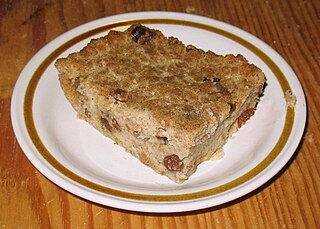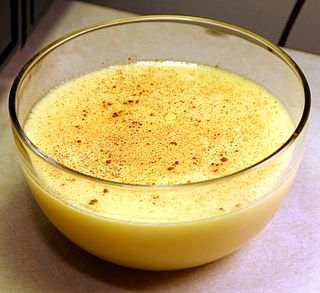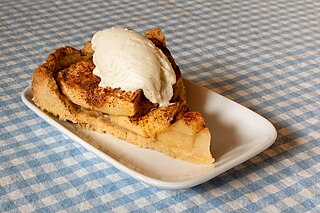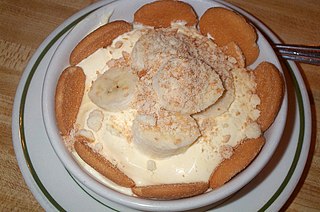Related Research Articles

Dessert is a course that concludes a meal. The course consists of sweet foods, such as cake, biscuit, ice cream and possibly a beverage such as dessert wine and liqueur. Some cultures sweeten foods that are more commonly savory to create desserts. In some parts of the world there is no tradition of a dessert course to conclude a meal.

Bread pudding is a bread-based dessert popular in many countries' cuisines. It is made with stale bread and milk or cream, generally containing eggs, a form of fat such as oil, butter or suet and, depending on whether the pudding is sweet or savory, a variety of other ingredients. Sweet bread puddings may use sugar, syrup, honey, dried fruit, nuts, as well as spices such as cinnamon, nutmeg, mace, or vanilla. The bread is soaked in the liquids, mixed with the other ingredients, and baked.

Custard is a variety of culinary preparations based on sweetened milk, cheese, or cream cooked with egg or egg yolk to thicken it, and sometimes also flour, corn starch, or gelatin. Depending on the recipe, custard may vary in consistency from a thin pouring sauce to the thick pastry cream used to fill éclairs. The most common custards are used in custard desserts or dessert sauces and typically include sugar and vanilla; however, savory custards are also found, e.g., in quiche.

An apple pie is a pie in which the principal filling is apples. Apple pie is often served with whipped cream, ice cream, custard or cheddar cheese. It is generally double-crusted, with pastry both above and below the filling; the upper crust may be solid or latticed. The bottom crust may be baked separately ("blind") to prevent it from getting soggy. Deep-dish apple pie often has a top crust only. Tarte Tatin is baked with the crust on top, but served with it on the bottom.

Cheesecake is a dessert made with a soft fresh cheese, eggs, and sugar. It may have a crust or base made from crushed cookies, graham crackers, pastry, or sometimes sponge cake. Cheesecake may be baked or unbaked, and is usually refrigerated.

Lemon ice box pie is an icebox pie consisting of lemon juice, eggs, and condensed milk in a pie crust, frequently made of graham crackers and butter. It is a variant of key lime pie; in both, the citric acidity sets the egg yolks, with minimal baking. There are also no bake versions.

Apple cakes are cakes in which apples feature as a main flavour and ingredient. Such cakes incorporate apples in a variety of forms, including diced, pureed, or stewed, and can include common additions like raisins, nuts, and 'sweet' spices such as cinnamon or nutmeg. They are a common and popular dessert worldwide, thanks to millennia of apple cultivation in Asia and Europe, and their widespread introduction and propagation throughout the Americas during the Columbian Exchange and colonisation. As a result, apple desserts, including cakes, have a huge number of variations.

Banana cream pie is a variation of a cream pie which includes sliced bananas.

A cream pie, crème pie, or creme pie is a type of pie filled with a rich custard or pudding that is made from milk, cream, sugar, wheat flour, and eggs and typically topped with whipped cream.

Banana pudding is a pudding generally consisting of layers of sweet vanilla flavored custard, vanilla wafers and/or ladyfingers and sliced fresh bananas placed in a dish and served, topped with whipped cream or meringue.

An icebox cake is a dairy-based dessert made with cream, fruits, nuts, and wafers and set in the refrigerator. One particularly well-known version used to be printed on the back of boxes of thin and dark Nabisco Famous Chocolate Wafers.

Sponge cake is a light cake made with eggs, flour and sugar, sometimes leavened with baking powder. Some sponge cakes do not contain egg yolks, like angel food cake, but most of them do. Sponge cakes, leavened with beaten eggs, originated during the Renaissance, possibly in Spain. The sponge cake is thought to be one of the first non-yeasted cakes, and the earliest attested sponge cake recipe in English is found in a book by the English poet Gervase Markham, The English Huswife, Containing the Inward and Outward Virtues Which Ought to Be in a Complete Woman (1615). Still, the cake was much more like a cracker: thin and crispy. Sponge cakes became the cake recognised today when bakers started using beaten eggs as a rising agent in the mid-18th century. The Victorian creation of baking powder by English food manufacturer Alfred Bird in 1843 allowed the addition of butter to the traditional sponge recipe, resulting in the creation of the Victoria sponge. Cakes are available in many flavours and have many recipes as well. Sponge cakes have become snack cakes via the Twinkie.

Instant pudding is an instant food product that is manufactured in a powder form and used to create puddings and pie filling. It is produced using sugar, flavoring agents and thickeners as primary ingredients. Instant pudding can be used in some baked goods.

Mango float or crema de mangga is a Filipino icebox cake dessert made with layers of ladyfingers (broas) or graham crackers, whipped cream, condensed milk, and ripe carabao mangoes. It is chilled for a few hours before serving, though it can also be frozen to give it an ice cream-like consistency. It is a modern variant of the traditional Filipino crema de fruta cake. It is also known by various other names like mango refrigerator cake, mango graham float, mango royale, and mango icebox cake, among others. Crema de mangga is another version that additionally uses custard and gulaman (agar) or gelatin, as in the original crema de fruta.
Pie in American cuisine has roots in English cuisine and has evolved over centuries to adapt to American cultural tastes and ingredients. The creation of flaky pie crust shortened with lard is credited to American innovation.
References
- 1 2 "What Are Icebox Pies and Why Are Southerners So Crazy About Them?". Southern Living.
- 1 2 "Ice box pie history". What's Cooking America. 19 May 2015.
- ↑ "Old-fashioned icebox pies are easy and delicious". The San Diego Union-Tribune. 4 June 2019. Retrieved 8 September 2021.
- ↑ The Star Press, Muncie, Indiana, 08 May 1937